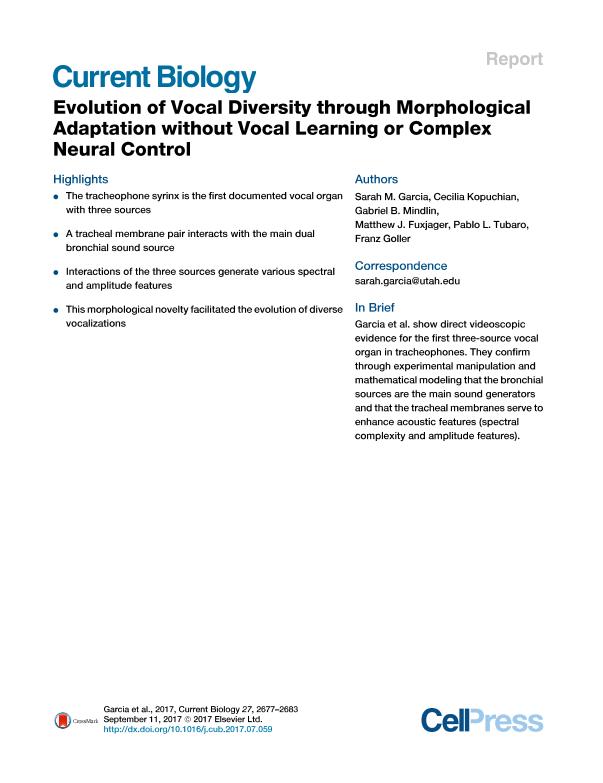Artículo
Evolution of vocal diversity arises through morphological adaptation in the absence of vocal learning and complex neural control
Garcia, Sarah; Kopuchian, Cecilia ; Mindlin, Bernardo Gabriel
; Mindlin, Bernardo Gabriel ; Fuxjager, Matthew; Tubaro, Pablo Luis
; Fuxjager, Matthew; Tubaro, Pablo Luis ; Goller, Franz
; Goller, Franz
 ; Mindlin, Bernardo Gabriel
; Mindlin, Bernardo Gabriel ; Fuxjager, Matthew; Tubaro, Pablo Luis
; Fuxjager, Matthew; Tubaro, Pablo Luis ; Goller, Franz
; Goller, Franz
Fecha de publicación:
09/2017
Editorial:
Cell Press
Revista:
Current Biology
ISSN:
0960-9822
Idioma:
Inglés
Tipo de recurso:
Artículo publicado
Clasificación temática:
Resumen
The evolution of complex behavior is driven by the interplay of morphological specializations and neuromuscular control mechanisms [1–3], and it is often difficult to tease apart their respective contributions. Avian vocal learning and associated neural adaptations are thought to have played a major role in bird diversification [4–8], whereas functional significance of substantial morphological diversity of the vocal organ remains largely unexplored. Within the most species-rich order, Passeriformes, “tracheophones” are a suboscine group that, unlike their oscine sister taxon, does not exhibit vocal learning [9] and is thought to phonate with tracheal membranes [10, 11] instead of the two independent sources found in other passerines [12–14]. Here we show tracheophones possess three sound sources, two oscine-like labial pairs and the unique tracheal membranes, which collectively represent the largest described number of sound sources for a vocal organ. Birds with experimentally disabled tracheal membranes were still able to phonate. Instead of the main sound source, the tracheal membranes constitute a morphological specialization, which, through interaction with bronchial labia, contributes to different acoustic features such as spectral complexity, amplitude modulation, and enhanced sound amplitude. In contrast, these same features arise in oscines from neuromuscular control of two labial sources [15–17]. These findings are supported by a modeling approach and provide a clear example for how a morphological adaptation of the tracheophone vocal organ can generate specific, complex sound features. Morphological specialization therefore constitutes an alternative path in the evolution of acoustic diversity to that of oscine vocal learning and complex neural control.
Palabras clave:
FUNCTIONAL MORPHOLOGY
,
SUBOSCINE
,
SYRINX
,
TRACHEOPHONE
Archivos asociados
Licencia
Identificadores
Colecciones
Articulos(CECOAL)
Articulos de CENTRO DE ECOLOGIA APLICADA DEL LITORAL (I)
Articulos de CENTRO DE ECOLOGIA APLICADA DEL LITORAL (I)
Citación
Garcia, Sarah; Kopuchian, Cecilia; Mindlin, Bernardo Gabriel; Fuxjager, Matthew; Tubaro, Pablo Luis; et al.; Evolution of vocal diversity arises through morphological adaptation in the absence of vocal learning and complex neural control; Cell Press; Current Biology; 27; 17; 9-2017; 2677-2683
Compartir
Altmétricas



